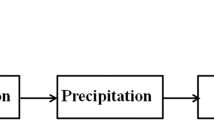Abstract
This paper summarises theadvantages and disadvantages effects of themost commonly used oxidants and disinfectants:chlorine, ozone, advanced oxidation withozone/hydrogen peroxide, chlorine dioxide,potassium permanganate and chloramines, ontastes and odours present in natural anddrinking waters. Case studies are presentedwhich illustrate the generation of odorousby-products such as chlorophenols, iodinatedtrihalomethanes, aldehydes, the masking effectbetween earthy-musty and chlorinous odours andthe removal of odorous algal metabolites oranthropogenic pollutants by ozone alone orozone coupled with hydrogen peroxide.
Similar content being viewed by others
References
Anselme C, Suffet IH & Mallevialle J (1988) Effects of ozonation on tastes and odours. Jour. AWWA 10(80), octobre 88
Baylis JR, Elimination of Taste and Odour in water (1935) Engineering Societies Monographs. McGraw Hill Book Company, New York and London, 260 pp.
Bruchet A, N' Guyen DK, Mallevialle J & Anselme C (1989) Identification and behaviour of iodinated haloform medicinal odour. Sem. Proc.: Identification and Treatment of Taste and Odour Compounds, AWWA Ann. Conf. Los Angeles, CA
Bruchet A, Costentin E, Legrand MF & Mallevialle J (1992) Influence of the chlorination of natural nitrogenous organic compounds on tastes and odours in finished drinking waters. Wat. Sci. Tech. 25(2): 323–333
Burlingame GA, Muldowney JJ & Maddrey RE (1992) Cucumber flavour in Philadelphia's drinking water. Jour. AWWA 84(8): 92–97
Crane RI, Moore K & Fielding M (1996) Formation and occurrence of bromophenols, iodophenols, bromoanisoles and iodoanisoles in drinking water: An investigation of taste and odour potential. UKWIR report DW-05, UK Water Industry Research Ltd
Doré M (1985) The different mechanisms of the action of ozone on aqueous organic pollutants. In: Perry R & McIntyre AE (Eds) Proc. Intl. Conf. The Role of Ozone in Water and Wastewater Treatment. SP Press, London, England
Duguet JP, Bruchet A & Mallevialle J (1989) New advances in oxidation processes: The use of the ozone/hydrogen peroxide combination for the micropollutants removal in drinking water. Proc. IWSA Conf. "Organic Micropollutants". Barcelona
Duguet JP, Mallevialle J, Ho J & Suffet IH (1995) Oxidation processes chlorine and chloramines. In: Suffet IH, Mallevialle J & Kawczynski E (Eds) Advances in Taste-and-Odour Treatment and Control (pp 75–113). AWWARF-Lyonnaise des Eaux, 3
Gittelman TS & Yohe TL (1989) Treatment of the iodinated halo-form medicinal odours in drinking water. Sem. Proc.: Identification and Treatment of Taste and Odour Compounds, AWWA Ann. Conf. Los Angeles, CA
Glaze WH (1987) Drinking water treatment with ozone. Env. Sci. Tech. 21(3): 224–230
Hansson CR et al. (1987) Iodoform taste complaints in chloramination. Water Res. 21(10): 1265–1271.
Hoehn RC et al. (1990) Household odours associated with the use of chlorine dioxide. Jour. AWWA 82(4): 166–172.41
Hoigné J & Bader H (1976) The role of hydroxyl radical reactions in ozonation processes in aqueous solutions. Water Res. 10: 377
Hoigné J (1977) Ozonation of water: Selectivity and rate of oxidation of solutes. 3rd Congress of IOA. Paris
Hoigné J (1984) In: Rice RG & Netzer A (Eds) Ozone and its Practical Application. Ann Arbor Science Publishers, Inc., Ann Arbor, MI, USA
Hrudey SE et al. (1989) Swampy or swimming pool aldehyde odours caused by chlorination and chloramination. Sem. Proc. Identification and Treatment of Taste and Odour Compounds, AWWA Ann. Conf., Los Angeles, CA
Krasner SW & Barrett S (1984) Aroma and flavour characteristics of free chlorine and chloramine. Proc. AWWA WQTC. AWWA, Denver, CO
Lalezary S, Pirbazari M & McGuire MJ (1986) Oxidation of five earthy-musty taste and odour compounds. Jour. AWWA 78(3): 62–69
Mallevialle J & Suffet IH (1987) Identification and Treatment of Tastes and Odours in Drinking Water. American Water Works Association Research Foundation, 6666 West Quincy Ave. Denver, CO
Schalekamp M (1983) All about ozone. Its advantages and disadvantages in treating water. Aqua 3: 89
Suffet IH (1986) Removal of tastes and odours by ozone. Sem. Ozonation and Water Treatment. Proc. AWWA, Ann. Conf. Denver, CO, USA
Young WF, Horth H, Crane R, Ogden T & Arnott M (1996) Taste and odour threshold concentrations of potential potable water contaminants. Water Res. 30(2): 331–340.
Author information
Authors and Affiliations
Rights and permissions
About this article
Cite this article
Bruchet, A., Duguet, J. & Suffe, I. Role of oxidants and disinfectants on the removal, masking and generation of tastes and odours. Re/Views in Environmental Science and Bio/Technology 3, 33–41 (2004). https://doi.org/10.1023/B:RESB.0000040011.81065.25
Issue Date:
DOI: https://doi.org/10.1023/B:RESB.0000040011.81065.25




